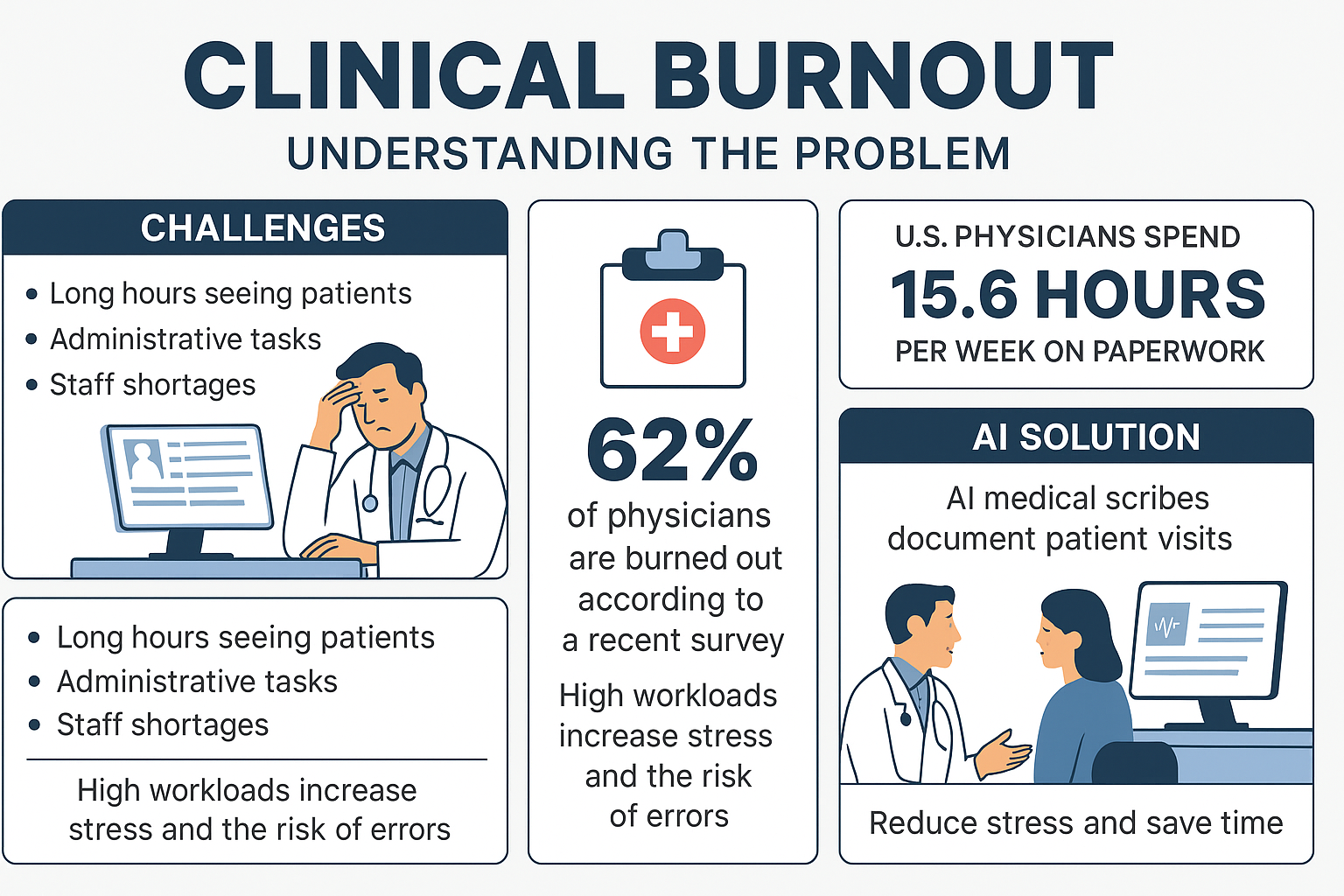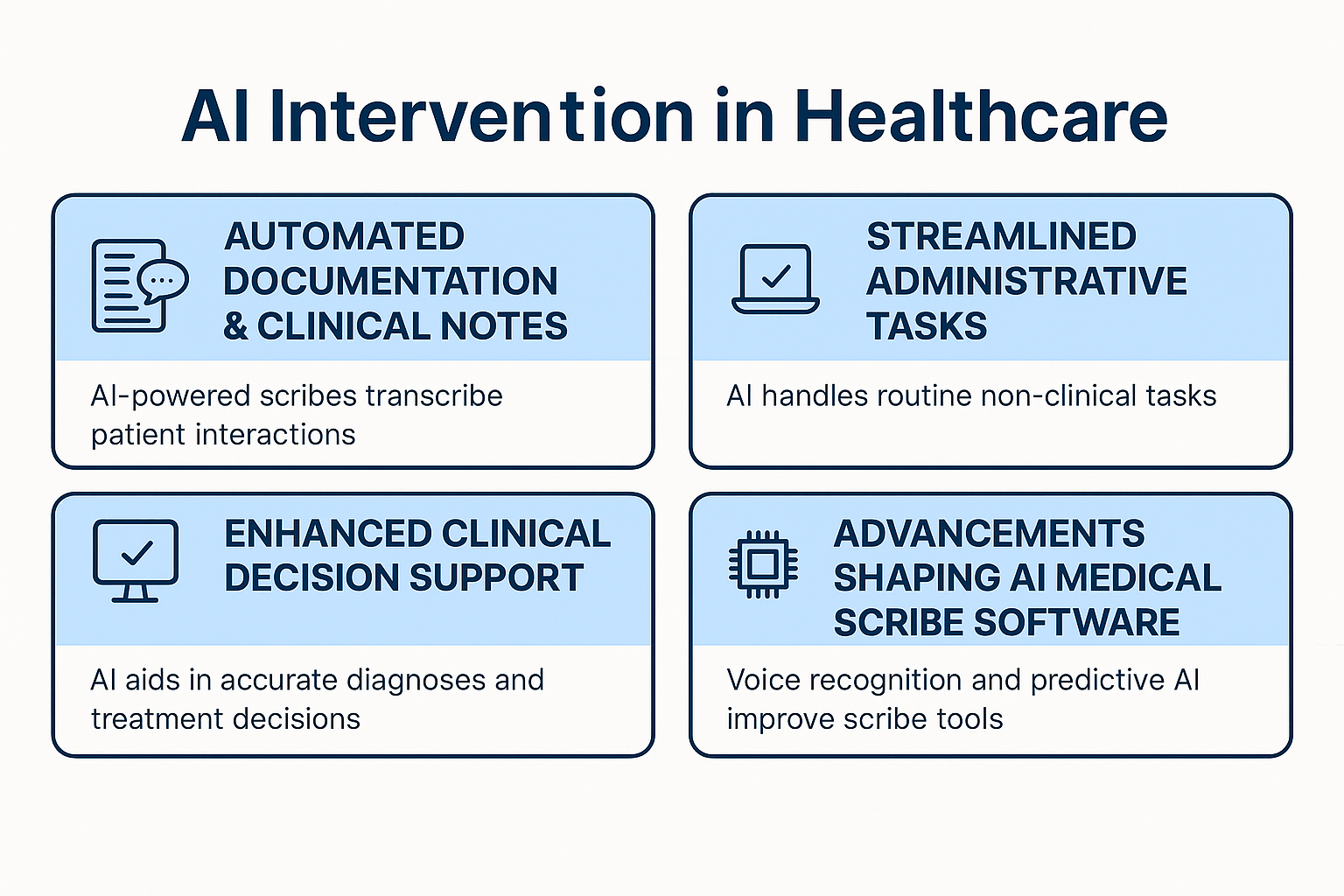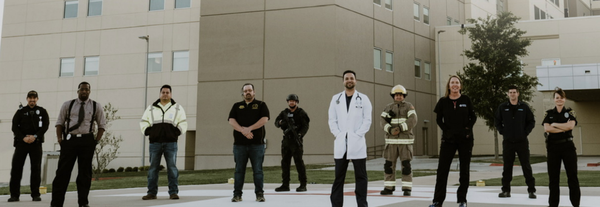How AI Can Reduce Clinical Burnout: The Case for AI Medical Scribes & Decision Support

Burnout is one of the most overlooked crises in healthcare today, despite being recognized by the World Health Organization as an “Occupational Phenomenon.” Physicians, in particular, are feeling the strain, as administrative overload, staffing shortages, and emotional fatigue take their toll. The situation raises real concerns about the sustainability of our healthcare system and the people who keep it running. Fortunately, AI is starting to show real promise- not as hype, but as a practical tool to reduce documentation burdens and give clinicians more time to think, connect, and breathe.
Clinical Burnout: Understanding the Problem
Doctors and other healthcare professionals have particularly demanding jobs compared to the average worker. They deal with patients day in and day out - people who need urgent care, make critical decisions, and have to handle loads of paperwork.
Tasks such as documentation, filling out approval forms, updating patient records, and other admin tasks, take up valuable time. This overload of administrative tasks in addition to typical clinical duties can lead to feelings of stress and burnout.
Patient records are important - they help hospitals run smoothly, and allow healthcare professionals to track patient care. That said, when doctors are left to manage it all by themselves - it becomes too much. And when they get tired or overwhelmed with all this, they are more likely to make mistakes.
This is where more practical use of technology is starting to help. With AI medical scribes, physicians can begin to offload a big chunk of their paperwork. How do these tools work? Well, these tools listen during patient visits and automatically come up with accurate medical notes - reducing stress and saving time.

AI Intervention in Healthcare
Automated documentation and clinical notes
When healthcare professionals meet patients, the goal is to listen carefully so as to make the patient feel heard. But they also need to take notes and keep records of the conversation. This is what complicates things! Because, it can’t be done without interrupting the patient or missing something important.
This is where physician burnout solutions such as AI-powered digital scribes come in handy. These smart tools are designed to listen in on the conversation and automatically turn it into neat, organized medical notes, all happening in real time.
Of course, the doctors still have to review/quickly check the notes once, and probably make one or two small changes, before the document can be added to the patient’s file. However, it is a simple way to save time, reduce stress, and let doctors focus on what really matters - their patients.
Streamlined administrative tasks
In the healthcare industry, admin tasks go far beyond just filling out forms. It includes anything and everything ranging from booking appointments to processing bills, handling documents, managing insurance claims, and coordinating follow-ups. This takes up a lot of time - not just for the hospital staff, but also for the doctors to oversee the process.
This is again where Artificial Intelligence (AI) is particularly useful. As tasks like these do not involve direct medical decisions, they can be safely handed over to AI. With some privacy and security measures in place, smart AI scribe tools can take over many of these duties. In fact, over the last few years, these tools have become better at their job. Such tools are known to work with accuracy and speed - thus reducing human error and the unnecessary long waiting times.
Enhanced clinical decision support
Doctors, as well as midlevels, often have to make quick, accurate decisions. Integrated AI co-pilots are being increasingly integrated to help with these high stakes decisions.
Modern AI tools are quite adept at handling vast amounts of patient data. They use this capability to identify patterns and potential risks. By processing electronic health records (EHRs), AI tools can assist in early disease detection and provide evidence-based recommendations. This can improve diagnostic accuracy and enhance treatment planning, allowing clinicians to focus more on connecting with their patient. This collaborative approach combines the strengths of both human expertise and machine precision.
Recent initiaves, such as Stargate, a 500 billion dollar effort aimed at advancing AI infrastructure, look to combine giants in the rapidly evolving AI space such as openAI and Oracle to leverage leverage AI and EHRs to improve healthcare processes and patient outcomes. This can be done by utilizing common language APIs such as HL7 and FHIR to allow for communication between the EHR and the AI programs, such as DocAssistant, to customize personalized diagnostic and therapeutic plans for patients and offload large amounts of the administrative tasks touched on earlier in this article.

Intelligent inbox management
Physician inboxes have quietly become one of the biggest drains on time and attention in clinical workflows. It’s a mix of low-priority noise and genuinely critical updates, everything from appointment reminders to lab results needed for surgery. Expecting doctors to manually manage all of it, on top of patient care, is unrealistic. This is where AI can actually be useful: sorting, prioritizing, and drafting responses so clinicians aren’t constantly context-switching just to stay caught up.
What makes this interesting isn’t just automation- it’s adaptation. Different specialties communicate differently. A radiologist’s inbox looks nothing like a pediatrician’s, and good AI systems can adjust to those patterns. They learn the tone, the urgency, the context and draft accordingly
Of course, this isn’t about removing human review. The final check still sits with the clinician. But if AI can cut the noise, surface what’s important, and take first-pass stabs at the rest, it gives doctors a shot at staying focused without letting anything slip through the cracks.
Advancements shaping AI medical scribe software
AI medical scribes are getting smarter every day, and much of the credit for this goes to advancements in voice recognition, automation, and Artificial Intelligence. These technologies are constantly evolving, thereby making AI scribe technology better at understanding medical conversations in real time. All this innovation is thus the reason that modern AI medical scribe software now support multiple languages.
With the recent surge in digital transformation in healthcare, AI medical scribes are poised to completely change how clinical documentation works. The result? Smoother workflows, less burnout, and happier patients.

How AI medical scribes work
Modern AI scribe tools have begun to transform how doctors handle documentation by recording and organizing patient visits without interrupting care. Here’s a quick rundown on the basics of how AI medical scribes work.
Real-time speech recognition
Emergening speech to text technologies essentially allow for LLMs to "listen" in on conversations between the doctor and their patients, and with intelligent prompting they can they output high quality patients notes- without needing the doctor to write or dictate a thing.
Contextual understanding
Novel AI tools can not only transcribe clinician patient conversations, but also understand them, allowing for the organization of information into useful categories like symptoms, medications, and diagnoses, making the clinical notes more structured.
Compliance and security
Worried about data security? Don’t be! The top AI scribes are built with privacy in mind. Tools like DocAssistant follow strict guidlines, maintaining HIPAA compliance and other legal standards to make sure that patient data is protected at all times. Such tools securely work quietly in the background, allowing doctors to focus on their patients, and not on the paperwork.
Difference between traditional scribes and AI medical scribes
Winning the healthcare industry burnout war
Imagine a world where doctors could spend more time talking to patients and less time buried in paperwork. That’s exactly how AI scribe tools are helping healthcare professionals - and the results are pretty amazing. Designed to serve as physician burnout solutions, they’ve made the job of healthcare professionals a lot easier. No typing, no switching screens, no distractions.
Believe it or not, in modern clinics and hospitals, AI scribes are already reducing the pressure on healthcare staff. As mentioned earlier, they cut down hours of administrative work, lower chances of errors, and give doctors some breathing room - literally helping prevent burnout.
Healthcare is evolving, and AI scribes are a big part of making it smarter, more efficient, and more human again. In short, it’s a win for both medical professionals and patients.
Choosing DocAssistant for your AI scribe needs
To put it simply, physician burnout is a significant issue in healthcare today. Studies indicate that more than 50% of primary care physicians reported feeling burned out in 2022. This increased administrative burden requires novel and efficient products.
If you’re looking for such a product, we’d recommend DocAssistant. It is a powerful integrated AI-powered scribe and CDS tool designed to revolutionize clinical practice in the acute care setting. DocAssistant uses the aforementioned technologies to listen to doctor-patient conversations and instantly create gold standard documentation for the ER and Urgent Care.
DocAssistant comes with an evidence-based guidance feature. So, apart from the transcription feature, it also offers real-time clinical recommendations. This is backed by real, cited evidence, thereby helping doctors and midlevels make informed decisions in real time. So, it not only functions as a great AI medical scribe, aiding in burnout, but also boosts the confidence of healthcare professionals in their clinical decision-making.
DocAssistant implements advanced security protocols to ensure complete HIPAA compliance.
Developed by a team of US-trained physicians, this AI-powered tool is crafted to meet real-world challenges experienced by healthcare professionals. It has a user-friendly interface which further allows professionals to save time and improve patient interactions. So, by incorporating DocAssistant into your practice, you’ll be able to focus more on what really matters - delivering exceptional patient care.
Interested in stress-free documentation and more? Try DocAssistant today and see how AI can transform your practice
About the Author
Nathan Murray, M.D.
Dr. Nathan Murray is a Emergency Medicine trained physician and the founder of DocAssistant. With years of frontline clinical experience, Dr. Murray is passionate about leveraging AI to streamline administrative tasks and enhance clinical decision making



